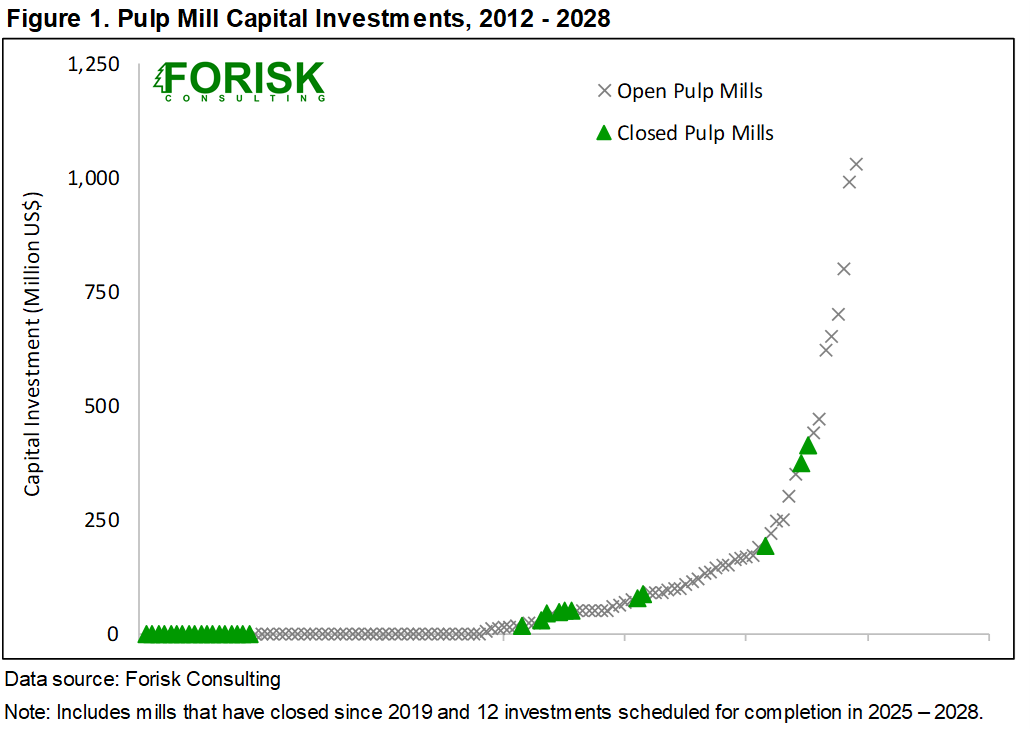| The Q4 2025 Forisk Research Quarterly (FRQ) report includes industry analysis and market forecasts through 2034 for timber prices, logging costs, softwood lumber production, structural panels production, paper and paperboard production, forest supplies, and wood bioenergy markets. Select summary findings from the Q4 FRQ report include:
Macro and Housing: The economy grew at a 3.8% annualized pace in Q2 2025. The unemployment rate increased to 4.3%. Yields on 10-year U.S. Treasuries fell to 4.3% in Q3 2025 from 4.4% during Q2. Single family starts declined 4.9% year-to-date through August 2025 compared to last year, while multifamily starts increased 19.4%.
Lumber: North American softwood lumber production gained nearly 7% quarter-over-quarter and increased less than 1% year-over-year through the first two quarters in 2025. The softwood lumber Producer Price Index rose by less than 1% in July 2025 and 5% year-over-year. U.S. South sawmill investments continue with $1.5 billion in announced projects from 2025 to 2027.
Structural Panels (OSB & Plywood): Quarter-over-quarter average U.S. structural panel prices declined 18% for OSB and 13% for plywood in Q3 2025. Capital projects in the sector will expand North American capacity by 3 BSF and cost ~$1.7 billion through 2027. Canada accounted for over 45% of all U.S. structural panel imports through September 2025.
Pulp & Paper: Paper and paperboard production is down 2.6% from the same period in 2024. Packaging production fell 2.4% for the quarter, newsprint was down 16.8% from Q3 2024, with printing/writing down 6.7%. Printing/writing and newsprint production continue to decline, while packaging and tissue grow. OCC prices dropped 11% in Q2 and are down 37% year-over-year. Average market pulp prices are down 3% year-over-year. U.S. pulp exports to China are down 48% year-over-year.
Wood Bioenergy: Bioenergy products that pass Forisk’s Wood Bioenergy Database screening plan to consume 97.1 million green tons per year of wood across the country. The U.S. South leads all regions in total projects and demand. Most bioenergy projects continue to be in the biomass-to-electricity, CHP, and pellet segments, though renewable hydrocarbon projects (liquid fuel and biochar) are increasing. Through July 2025, U.S. wood pellet exports increased 2% year-over-year while Canadian wood pellet exports increased 10% through August.
Log & Chip Exports: Through July 2025, U.S. North and U.S. South softwood log exports increased 6% year-to-date, while western softwood log exports decreased 50%. Canadian softwood log exports were down 12% year-over-year through July while U.S. softwood log exports were down 25% through July. U.S. South softwood chip exports for the period were flat over last year. Canada, Japan, and Vietnam, account for 80% of U.S. log and chip exports.
Timberland Investments: Public timber REITs returned -11.3% YTD through October 24th after returning -19.1% in 2024. Rayonier and Weyerhaeuser are trading down year-to-date while PotlatchDeltic is up. As a sector, public timber REITs decreased 7.2% for the quarter according to the market cap weighted Forisk Timber REIT Index (FTR). Just over 1.0 million acres of industrial timberland transactions closed in the United States for the last four quarters. TIMOs accounted for 55% of the acreage bought, while private sellers accounted for 41% of the acreage sold..
Forest Operations: U.S. logging employment over the last 4 quarters declined 3%, led by nearly 4% declines in the U.S. South and West. Canadian employment also dipped 3% year-over-year. Logging wages increased across North America, surging more than 4% in the U.S., with slower growth in Canada. Trucking freight shipments held flat while trucking employment fell another 2%.
Timber Markets, U.S. South: Southern stumpage prices decreased for pine sawtimber and all pulpwood products in Q3 2025, while prices increased for hardwood sawtimber, according to Timber Mart-South. The 2025 forecast for pine sawtimber implies a 1% decrease. Pine pulpwood stumpage prices are projected to increase the most through 2029 in Alabama.
Log Prices, Pacific Northwest: Domestic Doug-fir log prices fell 14% quarter-over-quarter in Oregon and 6% in Washington. Douglas-fir Japanese export (J-sort) prices dipped 1% while export hemlock prices were flat. Forisk’s “base case” projects a slight increase for Doug-fir prices in 2025 followed by larger increases in 2026. Logging and hauling costs are projected to increase slightly over the next decade.
Hardwood Markets, U.S. North: Forisk’s Hardwood Price Index increased decreased 2.8% in Q2 2025, up 3.9% year-over-year. On a percentage basis, ash sawlog prices in New England decline the most in 2025.
To learn more about the Forisk Research Quarterly (FRQ) subscription, click here or contact Nick DiLuzio (ndiluzio@forisk.com). | 






